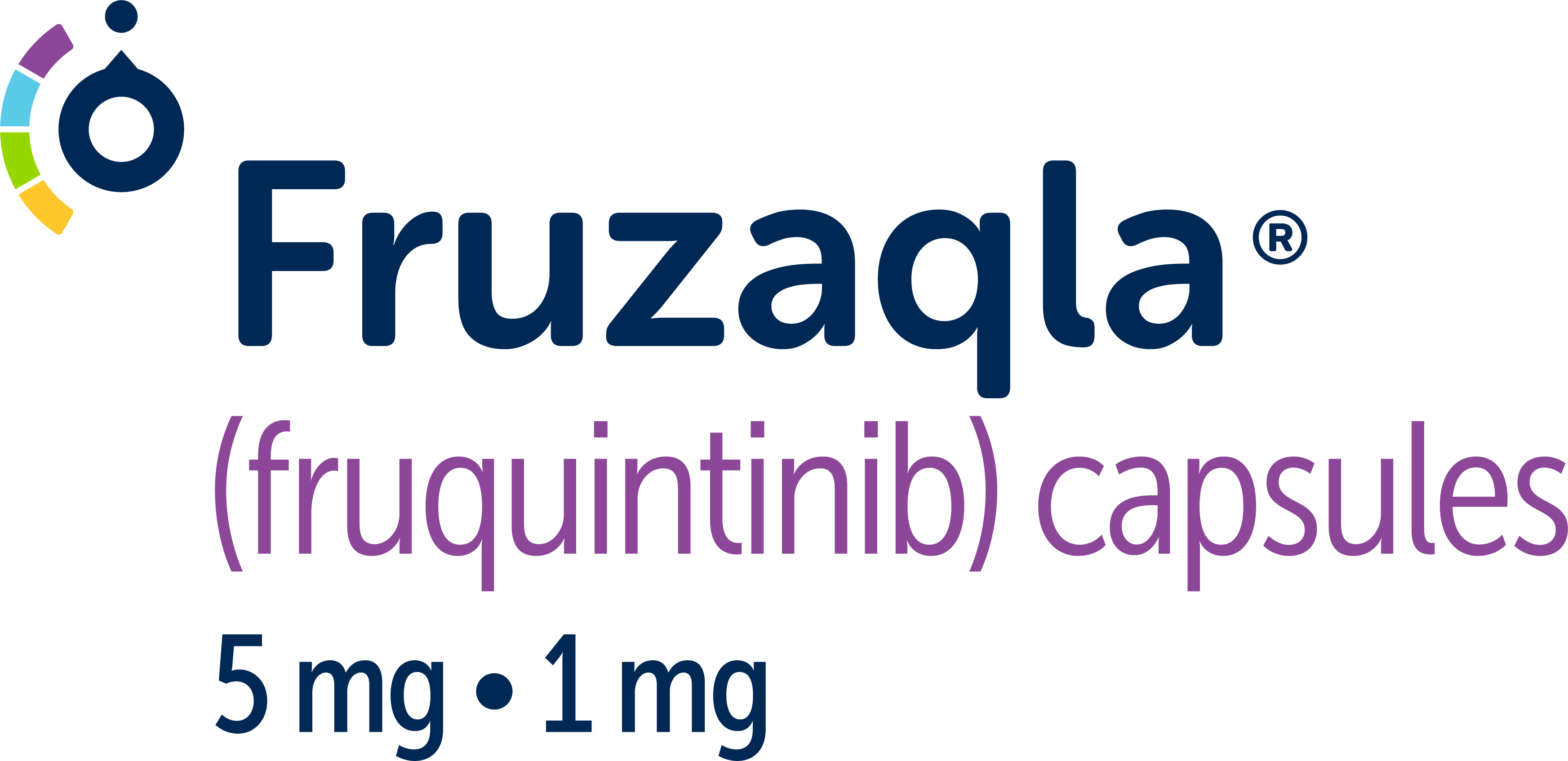IMPORTANT SAFETY INFORMATION AND INDICATION
Expand+WARNINGS AND PRECAUTIONS
- Hypertension occurred in 49% of 911 patients with mCRC treated with FRUZAQLA, including Grade 3-4 events in 19%, and hypertensive crisis in three patients (0.3%). Do not initiate FRUZAQLA unless blood pressure is adequately controlled. Monitor blood pressure weekly for the first month and at least monthly thereafter as clinically indicated. Initiate or adjust anti-hypertensive therapy as appropriate. Withhold, reduce dose, or permanently discontinue FRUZAQLA based on severity of hypertension.
- Hemorrhagic Events including serious, fatal events can occur with FRUZAQLA. In 911 patients with mCRC treated with FRUZAQLA, 6% of patients experienced gastrointestinal hemorrhage, including 1% with a Grade ≥3 event and 2 patients with fatal hemorrhages. Permanently discontinue FRUZAQLA in patients with severe or life-threatening hemorrhage. Monitor the International Normalized Ratio (INR) levels in patients receiving anticoagulants.
- Infections. FRUZAQLA can increase the risk of infections, including fatal infections. In 911 patients with mCRC treated with FRUZAQLA, the most common infections were urinary tract infections (6.8%), upper respiratory tract infections (3.2%) and pneumonia (2.5%); fatal infections included pneumonia (0.4%), sepsis (0.2%), bacterial infection (0.1%), lower respiratory tract infection (0.1%), and septic shock (0.1%). Withhold FRUZAQLA for Grade 3 or 4 infections, or worsening infection of any grade. Resume FRUZAQLA at the same dose when the infection has resolved.
- Gastrointestinal Perforation occurred in patients treated with FRUZAQLA. In 911 patients with mCRC treated with FRUZAQLA, 1.3% experienced a Grade ≥3 gastrointestinal perforation, including one fatal event. Permanently discontinue FRUZAQLA in patients who develop gastrointestinal perforation or fistula.
- Hepatotoxicity. FRUZAQLA can cause liver injury. In 911 patients with mCRC treated with FRUZAQLA, 48% experienced increased ALT or AST, including Grade ≥3 events in 5%, and fatal events in 0.2% of patients. Monitor liver function tests (ALT, AST, and bilirubin) before initiation and periodically throughout treatment with FRUZAQLA. Temporarily hold and then reduce or permanently discontinue FRUZAQLA depending on the severity and persistence of hepatotoxicity as manifested by elevated liver function tests.
- Proteinuria. FRUZAQLA can cause proteinuria. In 911 patients with mCRC treated with FRUZAQLA, 36% experienced proteinuria and 2.5% of patients experienced Grade ≥3 events. Monitor for proteinuria before initiation and periodically throughout treatment with FRUZAQLA. For proteinuria ≥2g/24 hours, withhold FRUZAQLA until improvement to ≤Grade 1 proteinuria and resume FRUZAQLA at a reduced dose. Discontinue FRUZAQLA in patients who develop nephrotic syndrome.
- Palmar-Plantar Erythrodysesthesia (PPE) occurred in 35% of 911 patients treated with FRUZAQLA, including 8% with Grade 3 events. Based on severity of PPE, withhold FRUZAQLA and then resume at the same or reduced dose.
- Posterior Reversible Encephalopathy Syndrome (PRES), a syndrome of subcortical vasogenic edema diagnosed by characteristic finding on MRI, occurred in one of 911 patients treated with FRUZAQLA. Perform an evaluation for PRES in any patient presenting with seizures, headache, visual disturbances, confusion, or altered mental function. Discontinue FRUZAQLA in patients who develop PRES.
- Impaired Wound Healing. In 911 patients with mCRC treated with FRUZAQLA, 1 patient experienced a Grade 2 event of wound dehiscence. Do not administer FRUZAQLA for at least 2 weeks prior to major surgery. Do not administer FRUZAQLA for at least 2 weeks after major surgery and until adequate wound healing. The safety of resumption of FRUZAQLA after resolution of wound healing complications has not been established.
- Arterial Thromboembolic Events. In 911 patients with mCRC treated with FRUZAQLA, 0.8% of patients experienced an arterial thromboembolic event. Initiation of FRUZAQLA in patients with a recent history of thromboembolic events should be carefully considered. In patients who develop arterial thromboembolism, discontinue FRUZAQLA.
- Allergic Reactions to FD&C Yellow No. 5 (Tartrazine) and No. 6 (Sunset Yellow FCF). FRUZAQLA 1 mg capsules contain FD&C Yellow No. 5 (tartrazine), which may cause allergic-type reactions (including bronchial asthma) in certain susceptible persons. FRUZAQLA 1 mg contains FD&C Yellow No. 6 (sunset yellow FCF), which may cause allergic reactions.
- Embryo-Fetal Toxicity. Based on findings in animal studies and its mechanism of action, FRUZAQLA can cause fetal harm when administered to pregnant women. Advise pregnant women of the potential risk to a fetus.
ADVERSE REACTIONS
The most common adverse reactions (incidence ≥20%) following treatment with FRUZAQLA included hypertension, palmar-plantar erythrodysesthesia (hand-foot skin reactions), proteinuria, dysphonia, abdominal pain, diarrhea, and asthenia.
DRUG INTERACTIONS
Avoid concomitant administration of FRUZAQLA with strong or moderate CYP3A inducers.
USE IN SPECIFIC POPULATIONS
- Lactation: Advise women not to breastfeed during treatment with FRUZAQLA and for 2 weeks after the last dose.
- Females and Males of Reproductive Potential
- Pregnancy Testing: Verify pregnancy status of females of reproductive potential prior to initiating FRUZAQLA.
- Contraception: Females of childbearing potential and males with female partners of childbearing potential should use effective contraception during treatment and for 2 weeks after the last dose of FRUZAQLA.
- Infertility: Advise females of reproductive potential that FRUZAQLA may cause post-implantation loss.
To report SUSPECTED ADVERSE REACTIONS, contact Takeda Pharmaceuticals at 1-844-662-8532 or the FDA at 1-800-FDA-1088 or www.fda.gov/medwatch.
Please see FRUZAQLA (fruquintinib) full Prescribing Information.
INDICATION
FRUZAQLA is indicated for the treatment of adult patients with metastatic colorectal cancer (mCRC) who have been previously treated with fluoropyrimidine-, oxaliplatin-, and irinotecan-based chemotherapy, an anti-VEGF therapy, and, if RAS wild-type and medically appropriate, an anti-EGFR therapy.
